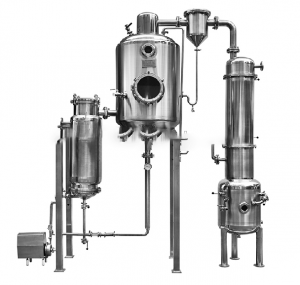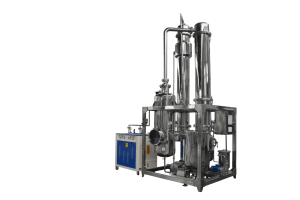Both a rising film evaporator and a falling film evaporator are effective evaporators, but there are still some differences between them.
Different Working Principles
1. Working Principle of a Rising Film Evaporator

A rising film evaporator is the evaporator in which the liquid material is added from the bottom of the heating chamber after the liquid material is preheated to or close to the boiling point. The liquid material will vaporize intensely inside the heating tube and the generated vapor will drive the liquid material to rise along the tube wall in the form of film. The liquid material evaporates continuously in the rising process. The solution can reach to the required concentration by going through the heating tube only once. If the liquid material under normal temperature is directly introduced into the heating chamber, there is must be a part at the bottom of the heating chamber to heat the liquid material so that the liquid material can vaporize after reaching its boiling point. So the solution can’t flow on this part of the wall in the form of film. As a result, the liquid material must be preheated to or close to the boiling point before entering the evaporator.
2. Working Principle of a Falling Film Evaporator

The feed pump sends the materials to be processed into the top of evaporator heating chamber. After evenly distributed by the distribution plate, the materials flow vertically and uniformly in the form of film along the internal surface of the heating tube from top to bottom with the help of its own power. The steam outside the tube transfers heat to the materials by convection conduction. The secondary steam produced by the materials during the heating process flows rapidly with the materials from top to bottom. The gas-liquid mixture flows out from the lower end of the heating tube, and goes into the separation chamber for gas-liquid separation. The steam goes into the condenser for condensation and liquid phase is discharged from the separation chamber. The evaporation process is completed.
Different Applications
1. What is a Rising Film Evaporator Used for?
The material is added from the bottom and the secondary steam with a high steam velocity derives the material to rise and form the film along the tube wall. So a rising film evaporator should be used for materials with relatively low concentration and viscosity. It is suitable for materials with large evaporation capacity.
2. What is a Falling Film Evaporator Used for?
The material is added from the top and flows downward to form a film relying on the gravity and the affinity of material to the tube wall. The top requires an accurate distributor to assist that the material can be distributed in the form of film. A falling film evaporator should be used for materials with relatively high concentration and viscosity. It is suitable for materials with small evaporation capacity.
What are the Advantages of a Falling Film Evaporator?
A falling film evaporator can be widely used in industrial, chemical, biochemical, and other fields. It is more and more well-received because of several essential advantages, mainly as follows:
- The heat transfer coefficient is relatively large due to the material in the heat exchange tube is in the film state and has a fast flow rate.
- The low temperature difference can be selected, since the pipe material flows downward along the inner wall of the pipe by its own gravity.
- The chemical properties of heat sensitive materials won’t be affected because of the short residence time of the raw material in the heat exchange tube.
- The surface state of the heat exchange tube hardly affects the boiling of the material, because it exhibits convection boiling after the tube material is heated.
- It can save energy because the pipe side material is almost in the ambient temperature without pressure drop.
[title text=”Related Products” tag_name=”h2″ color=”rgba(32, 163, 219, 0.81)”]
[ux_products ids=”3043,3041,3028,3030″]
[title text=”Related Posts” tag_name=”h2″ color=”rgba(32, 163, 219, 0.81)”]
https://www.rotovap.cn/falling-film-evaporator-problems/3661.html
https://www.rotovap.cn/falling-film-evaporator-problems/3543.html
https://www.rotovap.cn/falling-film-evaporator-problems/3579.html
https://www.rotovap.cn/falling-film-evaporator-problems/3160.html
https://www.rotovap.cn/falling-film-evaporator-problems/3693.html
